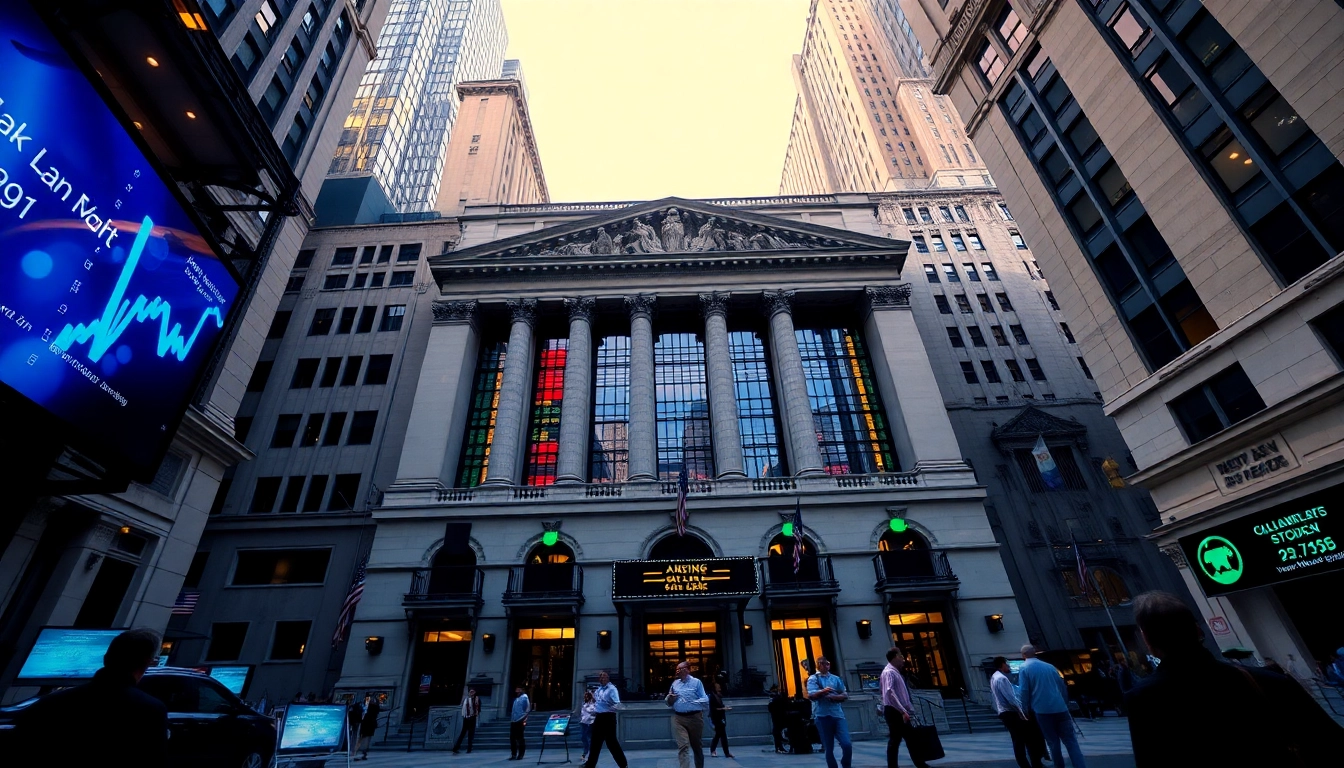Understanding the Stock Market in New York
The New York Stock Market stands as a pillar of the global financial system, symbolizing economic vitality, innovation, and the dynamic nature of modern investing. Home to the iconic New York Stock Exchange (NYSE), the city has long been at the forefront of financial operations and investment opportunities. For both seasoned investors and newcomers, understanding the intricacies of the market in this bustling metropolis is essential for crafting effective investment strategies and capitalizing on emerging opportunities. Whether you’re interested in trading stocks, analyzing market trends, or learning about the key players that drive the financial ecosystem, this guide aims to provide comprehensive insights into the vibrant world of the Stock Market New York.
History and Significance of the New York Stock Exchange
Established in 1792, the New York Stock Exchange (NYSE) is not only the oldest stock exchange in the United States but also among the most influential globally. Its historic trading floor, located on Wall Street, symbolizes American capitalism and economic resilience. Throughout its history, the NYSE has played a critical role in facilitating capital raising for businesses, setting financial benchmarks, and reflecting macroeconomic trends.
Major milestones, such as the integration of electronic trading in the 21st century, the 1987 stock market crash, and the resilience displayed during economic downturns, highlight its importance. The NYSE’s listing standards, liquidity, and high trading volumes make it a magnet for international investors seeking stability and growth prospects in the American economy. Its role extends beyond mere trading: it influences monetary policy, shapes investor sentiment, and contributes to the global financial narrative.
Key Players and Institutions in New York’s Financial District
At the heart of New York’s financial district lies a diverse ecosystem of influential institutions and key players. Iconic investment banks such as Goldman Sachs, Morgan Stanley, and Citigroup reside within Manhattan, providing a wide array of financial services—from asset management to mergers and acquisitions. Additionally, major hedge funds like Bridgewater Associates and Renaissance Technologies contribute significantly to the trading volume and market liquidity.
Regulatory agencies, including the Securities and Exchange Commission (SEC), oversee compliance and ensure market integrity. Major data providers and trading platforms like Bloomberg LP and Thomson Reuters equip investors with real-time information, enabling precise decision-making. The collaboration among these entities creates a robust infrastructure that supports both institutional and individual investors looking to optimize their portfolios.
Basics of Stock Trading and Investment Fundamentals
Stock trading in New York operates within a framework of fundamental principles that all investors should understand. At its core, investing involves purchasing shares of companies aiming for growth, income, or both. Typical trading strategies include long-term buying, short-term trading, and tactical asset allocation.
Essential concepts include understanding stock quotes, bid-ask spreads, and market orders. Investors need to familiarize themselves with key indicators such as price-to-earnings ratios, dividend yields, and moving averages. Risk management becomes paramount—diversification, stop-loss orders, and position sizing help mitigate potential losses. Furthermore, knowledge of fundamental analysis—assessing a company’s financial health—and technical analysis—interpreting market charts and signals—are crucial for making informed decisions tailored to the New York market environment.
How to Invest Effectively in the New York Stock Market
Developing a Solid Investment Strategy Tailored to New York Markets
Creating an effective investment strategy begins with defining clear goals—be it growth, income, or capital preservation. Given New York’s prominence in sectors like finance, technology, healthcare, and real estate, investors should allocate assets according to industry outlooks and individual risk tolerance. Diversification across sectors and company sizes reduces exposure to sector-specific downturns.
Furthermore, adopting a mix of passive and active investment approaches can optimize returns. Passive strategies involve broad market index funds tied to NYSE benchmarks, whereas active strategies focus on selecting individual stocks with strong fundamentals or growth potential. Regular reassessment of your portfolio ensures alignment with evolving market conditions and personal financial objectives.
Analyzing Stocks and Market Indicators Specific to New York
Investors should leverage data analytics and indicators rooted in the New York market. Corporate earnings reports, economic indicators such as employment data and interest rates, and sector-specific benchmarks provide insight into potential investment opportunities. Monitored indices like the Dow Jones Industrial Average and NYSE Composite offer snapshots of overall market health. Advanced tools like trading algorithms and sentiment analysis can augment decision-making, especially for short-term trading or sector rotation strategies.
Managing Risk and Diversifying Your Portfolio in New York
Effective risk management involves balancing exposure to high-volatility stocks with stable dividend-paying entities. Diversification—across sectors like technology, finance, healthcare, and real estate—helps cushion against individual sector downturns. Investors should also consider geographic diversification, including international stocks, to reduce reliance solely on the US economy.
Utilizing hedging techniques such as options and futures available on NYSE-listed products can further protect portfolios. Maintaining an emergency cash reserve and avoiding emotional reactions during market downturns ensure more disciplined investing practices.
Latest Trends and Opportunities in the New York Stock Market
Emerging Sectors and Innovative Companies Based in New York
New York continues to evolve as a hub for innovative sectors. Fintech startups disrupting traditional banking models and biotech firms advancing groundbreaking therapies are rapidly gaining prominence. The city’s adaptive regulatory environment fosters the growth of environmental, social, and governance (ESG) focused companies, many of which are publicly traded on NYSE or NASDAQ listings in the city.
Additionally, real estate investment trusts (REITs) centered around commercial properties and luxury developments offer attractive opportunities, especially in prime locations like Manhattan and Brooklyn. Investors should stay informed about these trends through industry reports, startup accelerators, and venture capital movements in the city.
Impact of Economic Policies and Events on New York Stocks
Economic policies at federal, state, and city levels significantly influence the New York stock scene. Tax reforms, monetary policy changes by the Federal Reserve, and fiscal stimulus packages can create volatility or boost growth prospects. Political events, such as elections or regulatory shifts, also impact investor confidence.
For example, a rollback of corporate taxes might enhance profitability for NY-based companies, leading to stock price rallies. Conversely, geopolitical tensions or unexpected economic shocks can induce market sell-offs. Staying attuned to news channels, economic calendars, and policy announcements is vital for timely responses.
Technological Advances and Their Influence on Trading in New York
Technological innovations like high-frequency trading, blockchain integration, and AI-driven analytics are transforming how trading occurs in New York. Electronic trading platforms have increased speed and transparency, enabling institutional and retail investors to execute trades within milliseconds.
Mobile trading apps, robo-advisors, and data-driven investment tools make the market more accessible, broadening participation. Keeping abreast of these technological shifts allows investors to harness automation and data analytics effectively, gaining a competitive edge in the highly competitive NY market environment.
Tools and Resources for Stock Market Investors in New York
Utilizing Data Analytics and Trading Platforms Tailored to New York
Investors benefit from using sophisticated trading platforms offering real-time data, charting tools, and algorithmic trading capabilities. Platforms like TD Ameritrade, E*TRADE, and Interactive Brokers provide access to NYSE trading, coupled with advanced analytical features designed for diverse investing styles.
Custom data analytics, visualization dashboards, and news aggregators help investors identify trends and execute timely trades. Incorporating these tools into your strategy enhances decision accuracy and execution speed, crucial in volatile markets like New York.
Accessing Financial News and Expert Insights Specific to New York
Staying informed is paramount. Leading financial news outlets such as Bloomberg, CNBC, and The Wall Street Journal offer dedicated coverage of New York markets. Specialized newsletters and analyst reports focus on NY-based companies, economic policies, and sector-specific developments, providing actionable insights.
Attending webinars, investor conferences, and local networking events in New York helps deepen market understanding and build connections with industry experts and fellow investors.
Educational Resources and Training for New York Investors
Numerous online courses, certifications, and workshops cater to investors interested in mastering the NY market. Institutions like the New York Institute of Finance and CFA Society New York provide comprehensive training in investment analysis, trading strategies, and compliance.
Continuous learning through simulation platforms, financial modeling tutorials, and mentorship programs ensures investors stay ahead of market trends and refine their investment approach.
Case Studies and Success Stories in the New York Stock Market
Profiles of Successful New York-Based Investors
Figures like Warren Buffett, although nationally renowned, had pivotal investment phases rooted in New York’s vibrant market environment. Many hedge fund managers and venture capitalists from New York have built fortunes navigating the complexities of the city’s financial ecosystem, leveraging sector insights and technological advances.
Case studies of such success stories reveal common themes: disciplined analysis, diversification, patience, and proactive risk management. Learning from these profiles can serve as a blueprint for aspiring traders and investors.
Lessons Learned from Market Downturns and Recoveries in New York
The 2008 financial crisis and the recent pandemic-induced downturn underscored the importance of resilience and strategic agility. Successful investors emphasized the need for liquidity preservation, sector rotation, and staying informed about economic stimuli and policy responses.
The recovery phases demonstrated the power of value investing and the potential for high-growth opportunities in emerging sectors, underscoring the importance of adaptive strategies in navigating downturns and capitalizing on recoveries.
Strategies That Delivered Consistent Growth in the New York Market
Avoiding speculative investments, maintaining diversified portfolios, and leveraging technological tools for timely trades have historically yielded consistent growth. Focusing on industries with long-term growth potential, such as technology and healthcare in New York, combined with disciplined risk management, enables sustained portfolio development.



